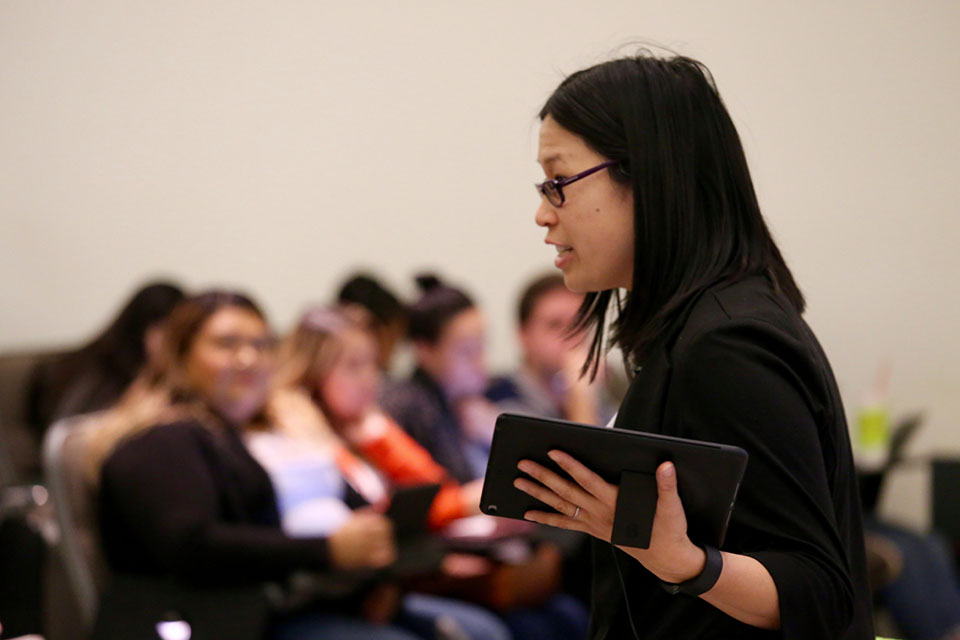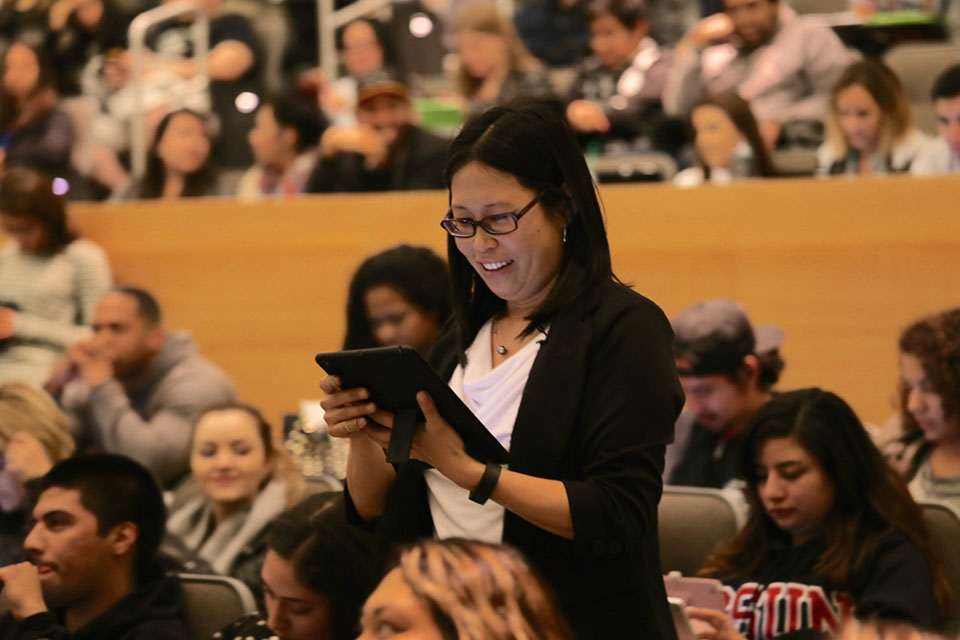eLearning Innovations: CSUN Professor Increases Student Engagement Through Technology
At this year’s California State University, Northridge eLearning Showcase, faculty demonstrated how technology can enhance the learning experience of students in the classroom. Presentations included Abraham Rutchick’s Hybrid 2.0: Real-time Online Section (ROS), Kaitlin Bahr’s BioStatsBuddy app and Sally Spencer’s Interactive Simulations: Bridging the Gap Between Course and Career. In this series, CSUN Today profiles each of these projects. This story explores assistant professor of psychology Stefanie Drew’s video iPads in Large Classes: Increasing Student Engagement.
It’s won acclaim on campus and recognition from industry leaders since debuting in 2013, but in the past academic year, the myCSUNtablet initiative really has gained traction among faculty and students at California State University, Northridge.
To call attention to new tools available, assistant professor of psychology Stefanie Drew earlier this year presented what’s available in iPad technology for CSUN students and faculty members in her video.
The myCSUNtablet program aims to engage CSUN students with digital learning material at reduced costs — as opposed to sitting in traditional courses and purchasing textbooks. myCSUNtablet enables students and professors to have a better interaction during and outside of class.
Drew, who uses myCSUNtablet in some of her psychology courses, said that iPads allow her to offer more in-class assignments.
“It’s far easier for students to upload assignments in class, since the iPad is already linked up to [Canvas], the campus’ learning management system,” Drew said. “I can do more engaging activities, and we don’t lose time writing down ID numbers.”
She explained that to involve her students in class, she leaves blanks in her notes, which they fill out together during class time, and she plays games on Kahoot! — a website where an unlimited number of “players” are asked questions about the class subject in a game-like learning environment.
“By filling in the blanks, [students] are physically doing active learning, which the literature shows is more effective for students to learn, as opposed to passive learning,” Drew said. “There are a number of apps we use to engage with material, as well as online resources such as the resource Kahoot! It’s almost like a game show, which students really enjoy.”
Students who are unable to make her on-campus office hours can use their iPads to engage with her through Zoom, a video chat app, Drew added. Zoom allows users to share documents and make comments on those documents, much like what would happen during in-person office hours.
“I can now Zoom with any of my students,” she said. “I still have my regular office hours, but not everyone can make it to campus then, [especially those with longer commutes]. I’ve had Saturday night office hours because students have their iPad, and [all they need is WiFi].”
Dominic Ceroni ’16 (Psychology), a student in one of Drew’s iPad classes, said he enjoyed the integration of iPads in his class for more than one reason.
“[Having an iPad in the classroom] creates an innovative and interactive experience for every single person in the class,” Ceroni said. “This is something that is especially useful when you’re in a class of 200. It makes you feel more involved and a part of the learning experience. I would without a doubt recommend the class to any fellow student.”
Some argue that having technology in the classroom is distracting, but Drew points out that this isn’t necessarily the case.
“There’s a misconception that [technology] is going to distract students and take away from their learning,” Drew said. “Being distracted in class is nothing new, even before iPads. I purposely do multiple activities in every class, so it’s very hard for [students] to do something else because they have to be engaged with the material.”
The myCSUNtablet initiative won the national Apple Distinguished Program award in 2015 and the Apple Distinguished School Award in 2017.
CSUN is also helping combat the expense of the technology. Currently, the classes that use iPads and the myCSUNtablet program are in CSUN’s Departments of Biology, Journalism, Kinesiology, Psychology, Physical Therapy and Public Health, and several in the College of Engineering and Computer Science.
Students within those departments have a few options for getting an iPad to use in class. They can arrange a payment plan with University Cash Services that includes the cost of the iPad in their tuition, and take the tablet with them when they graduate.
This is not an affordable option for every student, however, so there are also tablets available to be checked out at the Delmar T. Oviatt Library. Students can borrow these tablets at no charge for seven consecutive days, and take the tablets with them to class.
Additionally, some of the departments that participate in the myCSUNtablet initiative also have tablets that students can check out. Drew said that the array of options for obtaining a tablet was necessary since CSUN “wanted to make sure that every student has that option, one way or another, to have that device in their hands.”



 experience
experience